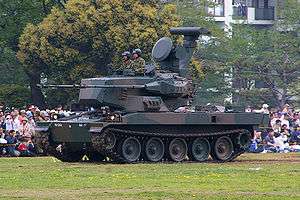List of modern equipment of the Japan Ground Self-Defense Force
| ||||||||||||||
The following is a list of modern equipment currently in service with the Japan Ground Self-Defense Force.
Uniforms
| Name | Used by | Notes | Period used | |
|---|---|---|---|---|
| Camouflage patterns | ||||
| Type I Camouflage | 1st Airborne Brigade, JGSDF Air Defense Artillery Groups | Also known as "Old Camo" or "Airborne Camo", it is the first camo scheme adopted by Japan after World War II. It is based on Hokkaido's wilderness(effective in Sasa veitchii field). The shades become distinguishable after wash, and the pattern itself doesn't match to the environment in mainland Japan, leading to the introduction of Type II camouflage. Copied by China in its Experimental PLA Woodland Flecktarn Camouflage. | 1970s–1990s (still in limited use in 2014) | |
 Type II Flecktarn camouflage |
Currently used by the JGSDF, the Japan Maritime Self-Defense Force, Japan National Defense Academy cadets, and JASDF Air Rescue Wings Pararescuemen. | Second domestically designed pattern. As in the case of the Type I has been copied by China. Made from 50% cotton/50% vinylon or 70% vinylon/30% cotton. The earlier model had anti-IR/flame-resistant fabric, but the latter lacks the feature. | 1991–present | |
 Type II brown-dominant winter pattern |
JGSDF | Darker contrast on Type II Flecktarn camo to fit the color of winter plants. Used on JGSDF Type-2 Camouflage Cold Weather Field Parka and Trousers(防寒戦闘服外衣, 戦闘外被, or shortly 外被). | 1991–present | |
 Type III Flecktarn camouflage |
Recently adopted by the JGSDF | Modified from ''Type II'' pattern with a 50% cotton/50% vinylon or 70% vinylon/30% cotton fabric(depending on the year of contract/manufacturer) and other changes including a change in the front closure, a mandarin collar, Velcro cuffs and pocket lids, wider pen pockets, a loop inside the right chest pocket for ID card chain, two calf storage pockets, and knee pads in the trousers. The back pocket on the trousers has been eliminated. The belt(made from the same fabric) comes with a name tag, unlike the former Type II Combat Uniform/Type II Camouflaged Work Uniform. The Type III Combat Uniform/Type III Camouflaged Work Uniform(戦闘服3型・迷彩作業服3型, or shortly 戦闘服) have the same pattern as the Type II camouflage. Each soldier receives two sets of the Type III Work Uniform after enlisting, and after the boot camp each soldier receives two sets of Type III Combat Uniform, Airborne Uniform or Tank Uniform, depending on the troop where the soldier belongs to. The Combat Uniform and Camouflaged Work Uniform are identical to each other, except for the product tag. Commercial version of the item (100% polyester version, cotton/poli version etc.) is no longer authorized to be used, including the vinylon/cotton fabric version. The use of commercial combat cap in vinylon/cotton fabric is authorized. The commercial versions have slightly different shades. | 2007–present | |
 JGSDF Desert Flecktarn camouflage |
JGSDF International Peace Cooperation Activities Training Unit, JGSDF Central Readiness Force | Recently adopted by the JGSDF for Middle Eastern deployments. This camo is a desert version of the JGSDF's flectarn pattern. The first unit using this particular camouflage was the Central Readiness Force during the 4th DAPE (Deployment Air Force for Counter-Piracy Operation) in the Gulf of Aden. | June 2010–present | |
(See also List of military clothing camouflage patterns [Asia A-M])
- Other equipment
- Type 66 helmet- It has now been mostly replaced by the Type 88 helmet. Like the American M1 helmet upon which it was based, it is made of iron alloy.
- Type 88 Helmet – Japanese version of Kevlar PASGT helmet replacing Type 66 helmet.
- Combat Underwear Type 2 – A khaki flame-resistant T-shirt, usually issued only one(each soldier has to purchase his own underwears) and mainly used for ceremonies etc.
- Helmet Liner, Type 2 – Used for light duty *current army regulation requires each soldier to wear gloves, a helmet and sleeve unrolled during light/heavy duties and field training
- Fulton MX991/U Flashlight – Used as "Signal Equipment" in Recon troops.
- Combat Loading Set – "戦闘装着セット”, issued in the troop where the soldier is assigned
- Combat Underwear Type 2 – A khaki flame-resistant T-shirt, usually issued only one(each soldier has to purchase his own underwear) and mainly used for ceremonies etc.
- Cold-Weather Combat Uniform Inner (Under) – A long-sleeved shirt and matching pants, made from thin synthetic fabric, often referred to as "カエル (frog)" from the fabric's fluorescent green
- Cold-Weather Combat Uniform Inner (Outer) – Acryl sweater and matching pants, comes with a buttoned collar which is worn folded, often referred to as "バッタ (grasshopper)" from its color
- Cold-Weather Combat Uniform Middle Layer – Often referred to as "宇宙服 (spacesuit)" from its shiny and bulky appearance
- Work Jacket – Issued as personal item. Intended to be used in cold seasons over the work uniform. Consists of two chest pockets and two lower pockets (with flaps without closures). Despite of the fact that the item is a cold-weather jacket, the camo version somehow contains hemp fabric, and is hoodless. Since the cold-weather combat jacket is warmer, rarely used in many troops.
- Combat Rainwear – The same item is issued as personal item(not as Combat Loading Set) but with a different name(Compact Rainwear Type 3), often mocked as "Shimitex(soak-tex)" or "Nisetex(sham-tex)", due to the poor water-proof coating which disappears after several use
- Combat Boots Type 2 – Jungle boots with kevlar-like lining, the same model issued as a personal item is called "半長靴3型 (Boots Type 3)"
- Cold-Weather Boots – Compatible with military issue cross-country skis
- Combat Bullet-Proof Vest – Storaged as weapon, instead of personal belonging, introduced in 1992. Comes with ammo pouches which aren't used to prevent damaging. In some troops Type 2 bullet-proof vest and/or Type 3 bullet-proof vest are issued .
- Type I Combat Rations – Can-meshi (canned type ration packs)[1]
- Type II Combat Rations – Pack-meshi (boiled in bag type ration packs)[1]
- Name Tags – Unlike the new rank/skill insignias (in green shade of the current camo), usually the name tags are in OD of Type 65 Work Uniform. Since the army regulation doesn't mention about the name tags, each unit has its own regulation for the tags. Therefore, the layout, length, font, letters (Japanese or Latin alphabets), place of wearing, how to attach the tag (either sewing or using velcro) etc. vary. Some troops do not use name tags for winter jackets.
- Tracksuits and running shoes – The recruits are demanded to buy their own tracksuits and a pair of running shoes, upon the enlistment. There is a uniform code called "ジャー戦 (Jaasen, literally jersey and combat uniform)”, which is composed of combat jacket, combat cap, trackpants and sneakers. This uniform code is often used in the boot camp for jogging, eating in canteen or going to bath, since it's easy to identify the name and the troop of the recruits. Any trackpants and sneakers are permitted for the code, for instance, it is possible to wear the following items: Nike Air Force 1, Adidas Superstar trackpants etc.
- 部隊識別帽 (Baseball Cap) – Many troops use baseball caps with the troop's logo instead of the issued combat cap. Since it is unofficially introduced, each soldier has to buy it by him/herself. There are no standards for the cap, although, in many cases the cap has the soldier's family name on top of the left ear.
- CAB Clothing Coolnice 2 Pack OD T-shirts – Issued to some troops during the 2011 Tohoku campaigns
- Carabiner – May be purchased individually, to attach it to the either right or left waist tab on the combat uniform to hang gloves or combat cap.
- Shoulder Pouch – May be purchased individually, since the combat uniform doesn't have shoulder pockets. There are various commercial versions. Some troops use the velcro version to attach unit patches, insignias etc..
See also: Field Ration – Asia
- Survival Ration Pack – (Emergency rations for aircrew, etc. Also used by ASDF & MSDF.)[1]
- Training Rations – (commercial style perishable food/drink items used in exercises, on base, and when supplying civilians at PR events or during disaster relief)[1]
- MCW/LRP ration – Japanese produced equivalent
- Personal protective equipment (Type 00)
Infantry weapons
| Name | Type | Origin | Notes | Picture | ||
|---|---|---|---|---|---|---|
| Guns | ||||||
| Standard issue | ||||||
| SCK/Minebea 9mm Pistol | Semi-automatic pistol | Made under license by Minebea Used with a leather holster or Safariland leg holster. | ||||
| Minebea 9mm Machine Pistol | Machine Pistol | Made by Minebea | 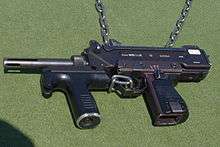 | |||
| Howa Type 89 | Assault rifle 5.56×45mm NATO | Made by Howa. Standard issue to front line units. A folding stock version is in production for soldiers who require a more compact rifle (including airborne, tank troops, mortars, recon troops etc.). | 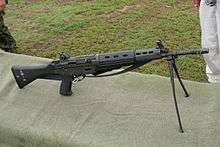 | |||
| Howa Type 64 | Battle rifle 7.62×51mm NATO | Made by Howa. Second line troops only, being replaced by the Type 89. |  | |||
| Sumitomo MINIMI 5.56mm Machine Gun | Light machine gun | Made under license by Sumitomo, standard squad machine gun. | 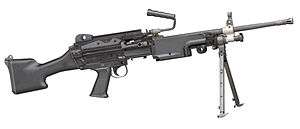 | |||
| NTK/Sumitomo Type 62 machine gun | General purpose machine gun 7.62×51mm NATO | Made by Sumitomo. Still used for infantry support as a Medium machine gun. Also used in vehicle-mounted roles. |  | |||
| NTK/Sumitomo Type 74 In-vehicle machine gun | In-vehicle machine gun | Made by Sumitomo | .jpg) | |||
| Sumitomo M2 12.7mm Heavy Machine Gun | Heavy machine gun | Made under license by Sumitomo. Copy of Browning M2. | 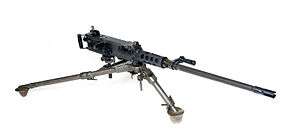 | |||
| M24 Sniper Rifle | Sniper Rifle | Made by Remington Arms. Standard sniper rifle of US Armed Forces, also used by reconnaissance sniper teams. | ||||
| Howa Type 64 Sniper Rifle | Sniper Rifle | Made by Howa. Adaptation of standard Type 64 rifle. No longer used as sniper rifle, still used extensively as infantry marksman's rifle. | .jpg) | |||
| Howa Type 96 40mm Automatic Grenade Launcher | Automatic Grenade Launcher | Made by Howa | ||||
| Type 06 rifle grenade | Rifle grenade | Made by Daikin | 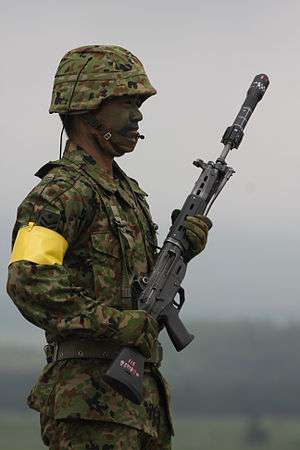 | |||
| M67 series fragmentation grenade | Hand grenade | Produced under license by a domestic concern (Daikin?). Still in at least limited service, including training and reserve units. | 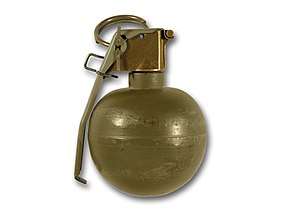 | |||
| M18 Claymore mine | Directional fragmentation Anti-personnel mine (Command activated) | Licensed production by? | 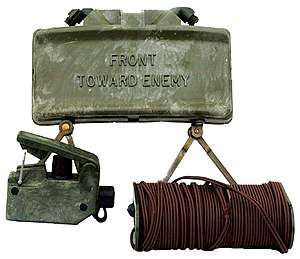 | |||
| Howa 84RR | Recoilless rifle | Made under license by Howa (had been imported from 1978 to 1984, Japanese-made ones can be distinguished by a darker green color). |  | |||
| Nissan/IHI Aerospace 110mm LAM | Anti-Tank rocket launcher | Made under license by Nissan/IHI IHI Aerospace |  | |||
| Special forces | ||||||
| H&K USP | Semi-automatic pistol | Only Japanese Special Forces Group. | 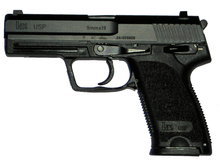 | |||
| H&K MP7 | Machine pistol | Only Japanese Special Forces Group. | 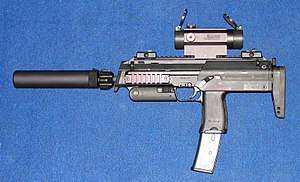 | |||
| M4 carbine | Assault rifle | Only Japanese Special Forces Group. |  | |||
| FN SCAR[2] | Assault rifle | Only Japanese Special Forces Group Made by FN Herstal. |
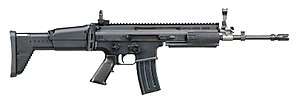 | |||
| Heckler & Koch G36[3] | Assault rifle | Only Japanese Special Forces Group Made by Heckler & Koch |
 | |||
| HK417[3] | Battle rifle | Only Japanese Special Forces Group Made by Heckler & Koch |
||||
| M203 grenade launcher | grenade launcher | Only Japanese Special Forces Group. | 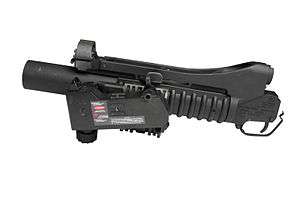 | |||
| M72 LAW (Light Anti-Tank Weapon) | Anti-Tank rocket launcher (Disposable) | Used by 1st Airborne Brigade, WAIR, and Japanese Special Forces Group. | .jpg) | |||
| M32A1 multi-shot grenade launcher | Grenade launcher | Only known to be in use with WAIR. |  | |||
| Mortars | ||||||
| Type 96 Heavy mortar (RT 120mm Mortar) | Heavy mortar | 430 | built under license with the ordnance by howa | |||
| L16 81mm Mortar | mortar | built under license with the ordnance by howa | 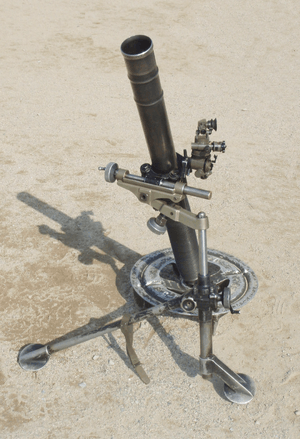 | |||
| Hirtenberger M6C-210
(60mm mortar) |
Light Mortar |  | ||||
| Howitzer | ||||||
| FH-70 Towed Howitzer | Howitzer | 480 | built under license with the ordnance by Japan Steel Works |  | ||
Missiles
Anti-tank, anti-ship missiles
- Type 01 Light Anti-Tank Missile (1,073)
- Type 79 Anti-Landing craft and Anti-Tank Missile
- Type 87 Anti-Tank Missile
- Type 88 Surface-to-Ship Missile
- Type 12 Surface-to-Ship Missile (6 sets now in service as of July 2013, deployed to the Western Army 5th and 6th Anti-Ship Missile Regiment)[4] The Type 12 is a major upgrade to the base Type 88 Missile.
- Type 96 Multi-Purpose Missile System
- Middle range Multi Purpose Missile System(Chū-MPMS) (46)
Surface-to-air missile
Vehicles
Other vehicles
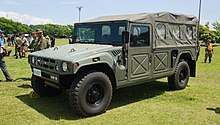
JGSDF Toyota High Mobility Vehicle in 2017
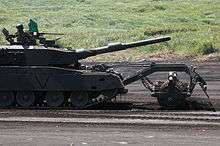
Type 92 mine roller
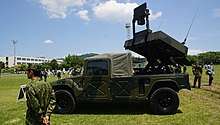
JGSDF Middle range Multi-Purpose missile system
- Combat Engineer Vehicle
- Type 91 AVLB (Armored Vehicle Launched Bridge)
- Hitachi Type 73 Artillery tractor
- Mitsubishi Type 73 Light Truck (Well equipped with an air conditioner and FM radio)
- Toyota Type 73 Medium Truck
- Isuzu Type 73 Heavy Truck
- Commercial grade trucks, e.g. Isuzu Forward (Used for peacetime/rear line tasks only)
- Ford Ranger
- Toyota High Mobility Vehicle
- Honda XLR250R Reconnaissance motorcycle
- Kawasaki KLX250 Reconnaissance motorcycle *Some are repainted in OD from the commercial green version
- Morooka ShizaiUnpansha (small tracked truck/materials carrier)
- Field Cooking Unit 1 – Mobile field kitchen, usually in the form of a well equipped trailer. Proved very useful during the aftermath of the 2011 Tōhoku disaster. The latest version, being introduced into service from 2012 onwards, is the Mark 22.
- M1A1 "Rear Car (cart)" – Used for carrying 102mm rounds for M2 Mortar. Other "Rear Cars (man-powered cart)" are widely used for various purposes, although they aren't officially introduced.
- Type 92 mine roller – Developed from 1988 onwards, accepted and received its Type designation in 1992 (causing some potential confusion with the Type 92 Mine Clearance Vehicle, see main Vehicles section). Incorporates electronic as well as mechanical mine countermeasures. Can be used by a wide range of GSDF vehicles, including the Type 74/Type 90/Type 10 MBTs, the Type 89 IFV, and the Type 87 SPAAG.
Aircraft
The JGSDF operates 497 fixed-wing and rotary aircraft (2014).[9]
| Name | Role | Type | Number[9] | Notes | Photo |
|---|---|---|---|---|---|
| Fixed-wing aircraft | |||||
| Bell Boeing V-22 Osprey | V/STOL military transport aircraft | V-22B Block C | 17 on order[10] | .jpg) | |
| Beechcraft Super King Air | Utility and Liaison | LR-2 | 7 | One lost on May 15, 2017.[11] | |
| Mitsubishi MU-2 | Utility and Liaison | LR-1 | 2 | ||
| Helicopters | |||||
| Boeing AH-64 Apache | Attack Helicopter | AH-64DJP | 12 | 13 built by Fuji. One crashed on 5th February 2018.[12] | |
| Bell AH-1 Cobra | Attack Helicopter | AH-1S | 88 | Built by Fuji | |
| Kawasaki OH-1 | Scout Helicopter | OH-1 | 38 | Up to 112 on order. Replacing the OH-6D fleet. | 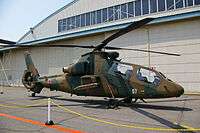 |
| OH-6D | Scout Helicopter | OH-6D | 106 | Built by Kawasaki. Being slowly replaced by the Kawasaki OH-1. | 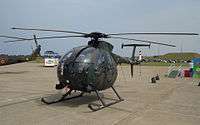 |
| Boeing CH-47 Chinook | Transport Helicopter | CH-47J CH-47JA |
58 | Built by Kawasaki | |
| UH-60 Black Hawk | Transport Helicopter | UH-60JA | 34 | Most built by Mitsubishi | |
| Bell UH-1 | Utility Helicopter | UH-1H UH-1J |
153 | Built by Fuji. To be replaced by a version of the Bell 412 EPI.[13][14][15][16] | |
| Enstrom 480 | Trainer helicopter | TH-480B | 12 | 8 on order. | _at_Camp_Akeno_October_2%2C_2016.jpg) |
| Eurocopter EC 225 | VIP Helicopter | EC 225LP | 3 | Replacing the AS332L[17][18] | |
| UAVs | |||||
| Fuji FFOS & Fuji FFRS | Recon UAV | Small helicopter UAV. Primarily used as a forward reconnaissance platform for field artillery.[19][20] | 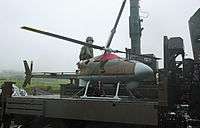 | ||
| Boeing Insitu ScanEagle | Recon UAV | 1 | Delivered by Insitu Pacific[21] | ||
| Yamaha R-MAX | Recon UAV | Small helicopter UAV[22] | |||
| Honeywell RQ-16 T-Hawk | Surveillance UAV | Apparently in service in some numbers with the Central Readiness Force. Used primarily for hazardous area reconnaissance (e.g. radiation survey). | 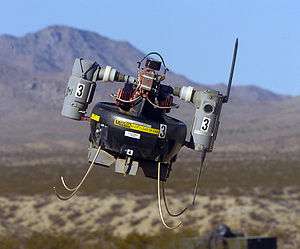 | ||
Historic, retired or reserve equipment
- Small arms
- M1 Garand semi automatic rifle[23] (Standard rifle of the JGSDF from shortly after its foundation up until the widespread adoption of the Type 64 battle rifle in the mid-1960s. Still in ceremonial use with some units.)
- M1 Carbine only M2 has Selective fire[23] (Inherited from National Safety Forces. Used in the JGSDF for training up until around the 1990s. Some reported to be still in storage with reserve units.)
- Type 99 short rifle (Kai Ki) – Old IJA rifles refurbished and modified to fire .30-06 Springfield rounds. Originally intended for the South Korean gendarmerie, most were diverted to help equip the National Police Reserve. Obsolete almost from the moment they were issued, were used up to the early 1970s mainly for training purposes.
- Thompson submachine gun [M1A1 variant] (Inherited from National Police Reserve. Was used by the GSDF until being gradually phased out in the 1970s.)
- M3 submachine gun[24]
- M1903 Springfield rifle
- M1918 Browning Automatic Rifle (Inherited from National Police Reserve)
- M1919 Browning machine gun
- M2 flamethrower (M2A1-2 & M2A1-7 variants)
- SCK New Nambu M66 submachine gun
- 11.4 mm pistol (Colt M1911) Pistol
- 9.65 mm pistol (Colt Detective Special revolver) (Inherited from National Police Reserve)
- Mk 2 defensive hand grenade (Ex-US Army stocks)
- M26 series fragmentation hand grenade
- MK3A1 Offensive Grenade (Ex-US Army stocks)
- M31 HEAT rifle grenade (Used with both the M1 Garand and Type 64 rifles. Still used for basic training and in reserve units.)

JGSDF soldiers in Type 65 work uniforms prepare to fire M31 HEAT rifle grenades during training.
- Other equipment
- Type 66 helmet – The inner shell is used occasionally as "中帽1型 (or "ライナー")" in boot camp, as an alternative for "中帽2型"
- U.S. Army M-1943 Uniform – Japanese produced variants of 1950 & 1951 patterns
- Type 65 Work Uniform
- M-1956 Load-Carrying Equipment – Japanese produced variant
- All-purpose Lightweight Individual Carrying Equipment – Japanese produced variant
- M1 and M1905E1 bayonets – Inherited from National Police Reserve
- M4 bayonet – Japanese modified/produced
- M5 bayonet – Japanese production
- C-rations
- P-38 can opener
- D-rations/Tropical Bars
- Ration, Cold Weather
- M-1942 mess kit
- T-10 parachute – Produced under licence by Fuji Sangyo Co. Ltd. (Fujikura Parachute)
- G-11 Cargo Parachute – Produced under licence by Fujikura Parachute
- G-12 Cargo Parachute – Produced under licence by Fuji Sangyo Co. Ltd.
Type 66 helmet
- Tanks
- M4 Sherman (M4A3E8/Easy Eight variant) (Ex-US Army inventory)
- M24 Chaffee (Ex-US Army inventory)
- M41 Walker Bulldog
- Type 61
- Artillery
- M1 155 mm Howitzer
- M2A1 105 mm Howitzer
- M2 203 mm Howitzer
- M59 155 mm Cannon
- Type 60 106 mm Self-propelled Recoilless gun
- Type 60 81 mm Self-propelled mortar
- Type 60 107 mm Self-propelled mortar
- Type 74 105 mm Self-propelled howitzer
- Type 75 130 mm Multiple Surface-to-Surface Rocket
- Type 30 Tactical Free Flight Rocket
- Anti-tank guided missiles
- TATM-2 ('Heavy' Anti-Tank Missile, in the same class as the Australian Malkara. Likely procured in very limited numbers.)
- Type 64 Anti-Tank Missile (Also known as ATM-1, or more commonly KAM-3D. Relatively small stocks still held in reserve)
- Anti-aircraft guns
- M19 Gun Motor Carriage SPAA (Ex-US Army inventory)
- M51 75 mm Anti-Aircraft Gun
- M42 40 mm Self-Propelled Anti-Aircraft Gun
- M-15 Self-propelled anti-aircraft machineguns (M15A1 CGMC) (Ex-US Army inventory)
- L-90 35mm Anti-Aircraft Twin Cannon
- Bofors 40 mm gun
- Other armored fighting vehicles
- Type 60 Armoured Personnel Carrier[25] (Also known as SU 60. A few examples modified late in life as KAM-3D ATGM carriers may still be in reserve.[26])
- M20 Armored Utility Car (A number of examples delivered to the NPR along with a few older M8s)
- Type 67 Armored Engineering Vehicle (Prototype [known as SD] created from the conversion by Mitsubishi Heavy Industries of a M4A3E8 in 1962, with production examples to be new build vehicles based on the Type 61 chassis. Planned procurement from 1967 onwards was precluded by financial constraints, however.)
- Light and Utility Vehicles
- Willys MB (Transferred from U.S. Army stocks at the time of the National Police Reserve.)
- Mitsubishi Jeep J2 (Inherited from National Safety Forces.)
- Toyota Jeep BJ (Developed to NPR requirement, first 298 examples delivered to National Safety Force in 1953 as its 'official patrol car'. Further procurement for the NSF curtailed. Note: Jeep BJ direct ancestor of Toyota Land Cruiser.)[27]
- Toyota/Nissan 3/4 ton truck (In service from 1950s to 1970s.)
- Toyota 2FQ-15 (FQ-10 ?) 4×4 truck (Inherited from NPR. Reportedly based on the Dodge M37.)[28]
- Toyota FQ-15 (known to U.S. Army as HQ-15) 6×6 heavy duty truck[29]
- Rikuo Type 97
- Harley-Davidson WLA (From U.S. Army Stocks, likely in relatively limited numbers but not confirmed.)
- Aircraft
- Kawasaki KAQ-1 (Target drone)
- Kawasaki KAT-1 (1 [First prototype])
- Beechcraft/Fuji T-34 Mentor (Model B45)
- Fuji LM-1 Nikko (27)[30]
- Fuji LM-2 (2)
- Fuji TL-1 (2)
- Mitsubishi (Sikorsky) H-19C (First general purpose helicopter procured for the GSDF, from 1954 onwards.)
- Kawasaki (Hughes) TH-55J Light utility and training helicopter (38)
- Kawasaki KH-4
- Kawasaki Heavy Industries (Hughes) OH-6 (387 produced under Licence)
References
- 1 2 3 4 Ration Packs for Japanese Forces Japan Security Watch
- ↑ http://www.mod.go.jp/gsdf/gmcc/hoto/hkou/14hk113.pdf
- 1 2 http://www.mod.go.jp/gsdf/gmcc/hoto/hkou/14hk093.pdf
- ↑ ja:12式地対艦誘導弾 Japanese Wikipedia entry on the Type 12 SSM, Accessed 9 July 2013.
- ↑ Category:JGSDF Type 82 (CCV) Wikimedia Commons
- ↑ ARG. "Type 96 Armored Personnel Carrier". Military-Today.com. Retrieved 2011-05-11.
- ↑ Kerr, Julian (24 May 2018). "Japan takes delivery of four more Bushmaster vehicles". IHS Jane's Defence Weekly. Retrieved 28 July 2018.
- ↑ Type 96 entry in the Self-Propelled Howitzers section at Deagel.com
- 1 2 "World Air Forces 2014". Flightglobal.com
- ↑ https://theaviationist.com/2017/08/26/here-is-japans-first-v-22-the-first-osprey-tilt-rotor-aircraft-for-a-military-outside-of-the-u-s/
- ↑ (in French)http://www.avionslegendaires.net/2017/05/actu/crash-dun-beechcraft-lr-2-japonais/
- ↑ https://headlines.yahoo.co.jp/hl?a=20180205-00050042-yom-soci
- ↑ Donald, David Fuji and Bell Working Together for UH-X July 12, 2017 AI Online Retrieved February 22, 2017
- ↑ Bell Helicopter Congratulates Fuji Heavy Industries on Japanese Ministry of Defense UH-X Contract Award September 2, 2015 Bell Helicopters Retrieved February 22, 2017
- ↑ FHI UH-X (Bell Model 412EPI) Military Troop Transport Helicopter / Support Gunship Military Factory Retrieved February 22, 2017
- ↑ UH-X Multipurpose Helicopter Global Security Retrieved February 22, 2017
- ↑ "Eurocopter Canada – News 04/07/06". Eurocopter.ca. Archived from the original on 7 May 2011. Retrieved 11 May 2011.
- ↑ EADS Press Release – Japan Defense Agency Received First EC225 In VIP Configuration For The Japanese Emperor’s Royal Flight Service Archived 29 September 2007 at the Wayback Machine.
- ↑ GSDF Fuji School 57th Open Day 2011 [Part Two] Japan Security Watch, 21 August 2011
- ↑ "Fuji FFOS (Japan), Unmanned helicopters – Rotary-wing – Military". Jane's Information Group. Retrieved 2011-08-10.
- ↑ Insitu Pacific Delivers ScanEagle UAS for the Japanese Ground Self Defense Force – Insitu.com, 14 May 2013
- ↑ "Yamaha RMAX (Japan), Unmanned helicopters – Rotary-wing – Civil". Jane's Information Group. Retrieved 2011-08-10.
- 1 2 Licensed by Howa.
- ↑ Small number of M3s are held in reserve by various JGSDF special forces units.
- ↑ Type 60 Armoured Personnel Carrier (Military-Today.com)
- ↑ The World Worlds – Weapons Database Type SU 60
- ↑ The rise of the Land Cruiser (Go4x4.eu)
- ↑ 2FQ-15 The Old Land Cruiser Company website
- ↑ http://www.brian894x4.com/MilitaryFQ15.html Toyota FQ-10 / FQ-15 / HQ-15 (195?-196?), MILITARY TOYOTAS
- ↑ Fuji LM-1 Nikko kamov.net
This article is issued from
Wikipedia.
The text is licensed under Creative Commons - Attribution - Sharealike.
Additional terms may apply for the media files.

.jpg)
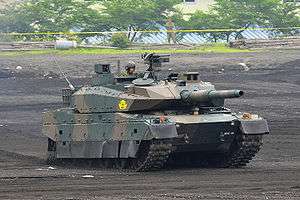
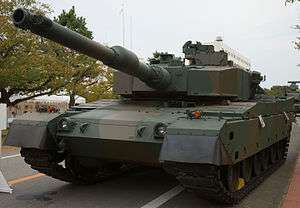
.jpg)
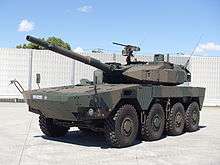
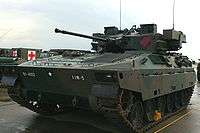

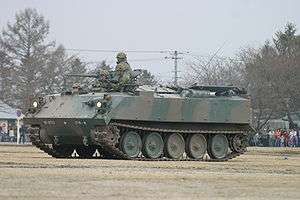


.jpg)
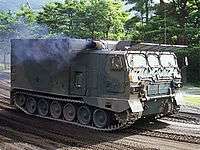
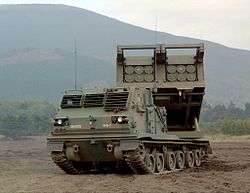
.jpg)
.jpg)
